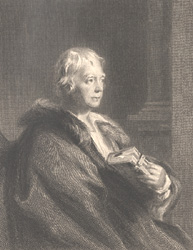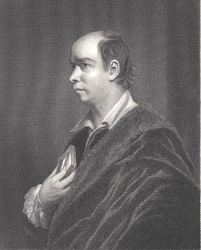|
|
Home | Corson Collection | Biography | Works | Image Collection | Recent Publications | Correspondence | Forthcoming Events | Links | E-texts | Contact Sir David Wilkie's Portrait of Sir Walter Scott (1824)
The 1824 portrait began life as a study for Wilkie's The Entrance of King George the Fourth at Holyrood, where Scott was to figure among the King's attendants. Scott granted Wilkie two sittings at Abbotsford on 9 and 10 November. The first was witnessed by the artist William Bewick who was surprised to find that Wilkie intended to model the picture on Sir Joshua Reynolds's portrait of Oliver Goldsmith. Bewick had expected hat Wilkie would aim for 'something of his own [...] an original impression of the individual character'. The house had been full of company, and Scott's guests had crowded into his library to watch Wilkie at work. Wilkie had seemed irritated by this circumstance, but Scott, an experienced sitter, had succeeded in maintaining his position while participating freely in the general conversation (Life and Letters of William Bewick, I, pp. 252-3). As Francis Russell argues, Wilkie's decision to model his portrait on Reynolds's Goldsmith suggests strongly that he intended the portrait to have an independent existence over and above its role as a sketch for The Entrance of King George. The elements imitative of Reynolds -- the open-neck collar, the position of the book -- are absent from the group portrait. For comparison, click on the thumbnail below to see an engraving of Reynolds's Goldsmith by J.H. Baker: The portrait was incomplete when Wilkie left for the Continent in 1825 in an effort to recover his health, which had been badly shaken by a series of family bereavements and by the financial collapse of his printsellers. Scott was 'deeply grieved' to hear of Wilkie's troubles for it was 'impossible for any man to have more admiration of his talents than I have, and yet even that was inferior to the regard inspired by the virtuous simplicity of his character'. During the sittings at Abbotsford, Scott had 'observed with regret [Wilkie] was in very low spirits, which I imputed to the illness of his mother'. 'I am convinced,' Scott added, 'that mere men of the world have not the slightest conception of the tax paid by artists, poets, and musicians for the power of giving them pleasure.' (To Sir George Beaumont, 28 August 1825, Letters, IX, 215.) Following his return in 1828, Wilkie worked up the portrait for Sir William Knighton. In January 1829, Wilkie wrote to Scott proposing that it be engraved for inclusion in the Magnum Opus edition of the Waverley Novels. Scott gratefully accepted the offer but was advised by the engraver Charles Heath that it was a very poor resemblance. Scott disliked and distrusted Heath and asked his son-in-law J.G. Lockhart for a second opinion. This proved equally negative, and the portrait did not appear in the Magnum Opus. Scott, however, declared himself 'extremely gratified' by Wilkie's depiction of his 'unworthy person' (to Wilkie, 1 February 1830, Letters, XI, 291). The portrait appears to have been engraved only once, by Edward Smith in 1829 (see top of page). Although the image was judged unsuitable for the Magnum Opus, Smith's engraving appeared in Cadell's edition of The Poetical Works of Sir Walter Scott (1830). Bibliography
Last updated: 30-May-2005
|
|||



